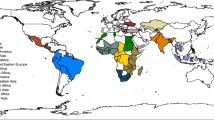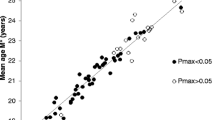Abstract
In the last decade, the study of birth intervals has been greatly facilitated by a rapid expansion in data availability and by improvements in analytical techniques. Unfortunately, the results emerging from individual level, empirical studies of birth interval dynamics do not correspond with the predictions of standard demographic theory. This paper reviews a series of individual level studies that find substantial socioeconomic variation in childspacing after controlling statistically for the major intermediate or proximate variables. It then offers possible explanations for the lack of fit between theory and results at the micro level, concluding that the two most likely explanations are poor measurement of the four principal proximate determinants and the exclusion of additional proximate determinants.
Similar content being viewed by others
References
Allison, Paul D. 1984 Event History Analysis: Regression for Longitudinal Event Data. Beverly Hills, CA: Sage.
Barrett, J. C. andJ. Marshall 1969 “The risk of conception on different days of the menstrual cycle.” Population Studies 23(3):455–461.
1978 “A framework for analyzing the proximate determinants of fertility.” Population and Development Review 4(1):105–132.
1982 “The fertility-inhibiting effects of the intermediate fertility variables.” Studies in Family Planning 13(6–7):178–189.
1983 “The proximate determinants of natural marital fertility.” In R. A. Bulatao and R. D. Lee with P. E. Hollerbach and J. Bongaarts (eds.), Determinants of Fertility in Developing Countries: A Summary of Knowledge. Washington, DC: National Academy Press.
Bumpass, Larry L., Ronald R. Rindfuss, andJames A. Palmore 1986 “Determinants of Korean birth intervals: The confrontation of theory and data.” Population Studies 40(3):403–423.
Butz, William P., Julie DaVanzo, Dorothy Z. Fernandez, Robert Jones, andNyle Spoelstia 1978 The Malaysian Family Life Survey: Appendix A, Questionnaires and Interviewer Instructions. Santa Monica, CA: The Rand Corporation.
Chamratrithirong, Apichat, S. Philip Morgan, and Ronald R. Rindfuss Forthcoming “Living arrangements and family formation.” Social Forces.
D'Souza, S. and L. C. Chen 1981 “Population laboratories for studying disease processes and mortality: The demographic surveillance system, Matlab, Bangladesh.” Paper presented at the Seminar on Methodology and Data Collection in Mortality Studies, Dakar, Senegal, July 7–10.
Davis, Kingsley andJudith Blake 1956 “Social structure and fertility: An analytic framework.” Economic Development and Cultural Change 4:211–235.
Freedman, Ronald, P. K. Whelpton, andArthur A. Campbell 1959 Family Planning, Sterility and Population Growth. New York: McGraw-Hill.
Gray, Ronald, Susan Eslami, Miriam Labbok, Howard Zacur, Oona Campbell, Ruben Apelo, andRebecca Ruben 1986 “Predictor of ovulation return in breastfeeding mothers: Report of an ongoing study.” Fertility Determinants Research Notes No. 9, Population Council, New York.
Guilkey, David andRonald R. Rindfuss 1987 “Logistic regression multivariate analysis: A communicable approach.” Sociological Methods and Research 16(2):276–300.
Guilkey, David, Ronald R. Rindfuss, Barry M. Popkin, John S. Akin, and Vincente Paqueo. Forthcoming “Child spacing in the Philippines: The effect of current characteristics and rural development.” Population Studies.
Heckman, J. J. andB. Singer 1984 “A method for minimizing the impact of distribution assumptions in econometric duration models.” Econometrica 52:271–320.
Hirschman, Charles andRonald R. Rindfuss 1982 “The sequence and timing of family formation events in Asia.” American Sociological Review 47:660–680.
Hong, Sung-bong andChristopher Tietze 1979 “Survey of abortion providers in Seoul, Korea.” Studies in Family Planning 10(5):161–163.
Huffman, S., A. Chowdhury, andW. Mosley 1978 “Postpartum amenorrhea: How is it affected by maternal nutritional status?” Science 200(4346):1155–1157.
Huffman, S., A. Chowdhury, andZ. Sykes 1980 “Lactation and fertility in rural Bangladesh.” Population Studies 34(2):337–347.
James, W. 1973 “The fecundability of U.S. women.” Population Studies 27(3):493–500.
Kallan, Jeffrey andJ. Richard Udry 1986 “The determinants of effective fecundity based on the first birth interval.” Demography 23(1):53–66.
Lachenbruch, P. 1967 “Frequency and timing of intercourse: Its relation to the probability of conception.” Population Studies 21(1):23–32.
Leridon, H. 1977 Human Fertility: The Basic Components. Chicago: University of Chicago Press.
Lesthaeghe, R. J. andHilary J. Page 1980 “The post-partum non-susceptible period: Development and application of model schedules.” Population Studies 34(1):143–170.
Mauldin, W. Parker andBernard Berelson 1978 “Conditions of fertility decline in developing countries, 1965–75.” Studies in Family Planning 9(5)89–147.
Menken, Jane 1979 “Seasonal migration and seasonal variation in fecundability: Effects on birth rates and birth intervals.” Demography 16(1):103–119.
Page, Hilary J., R. J. Lesthaeghe, andI. H. Shah 1982 “Illustrative analysis: Breastfeeding in Pakistan.” World Fertility Survey Scientific Reports No. 37. Voorburg, Netherlands: International Statistical Institute.
Palloni, Alberto 1984 “Assessing the effects of intermediate variables on birth interval-specific measures of fertility.” Population Index 50(4):623–657.
Rindfuss, Ronald R., Larry L. Bumpass, andJames A. Palmore 1987 “Analyzing fertility histories: Do restrictiens bias results?” Demography 24(1):113–122.
Rindfuss, Ronald R., Larry L. Bumpass, James A. Palmore, Mercedes B. Concepcion, Datin Noor Laily Datu' Abu Bakar, Sirisena Gamage, Chanpen Saengtienchai, andNam Il Kim 1984 “Childspacing in Asia: Similarities and differences.” World Fertility Survey Comparative Studies No. 29 Voorburg, Netherlands: International Statistical Institute.
Rindfuss, Ronald R. andS. Philip Morgan 1983 “Marriage, sex and the first birth interval: The quiet revolution in Asia.” Population and Development Review 9(2):259–278.
Rindfuss, Ronald R., James A. Palmore, andLarry L. Bumpass 1982 “Selectivity and the analysis of birth intervals from survey data.” Asian and Pacific Census Forum 8(3):5–6, 8–10, 15–16.
Rindfuss, Ronald R. and Elizabeth Hervey Stephen 1987 “Marital non-cohabitation: Separation does not make the heart grow fonder.” Unpublished manuscript, Department of Sociology, University of North Carolina.
Rodriquez, German andJohn N. Hobcraft 1980 “Illustrative analysis: Life table analysis of birth intervals in Colombia.” World Fertility Survey Scientific Reports No. 16. Voorburg, Netherlands: International Statistical Institute.
Rodriquez, German, John N. Hobcraft, John McDonald, Jane Menken, andJames Trussell 1984 “A comparative analysis of determinants of birth intervals. World Fertility Survey Comparative Studies No. 30. Voorburg, Netherlands: International Statistical Institute.
Rosenzweig, Mark R. andT. Paul Schultz 1985 “The demand for and the supply of births: Fertility and its life cycle consequences.” American Economic Review 75(5)992–1015.
Schwartz, D., P. MacDonald, andV. Heuchel 1980 “Fecundability, coital frequency and the viability of ova.” Population Studies 34(2):397–400.
Sheps, M. C. andJ. Menken 1973 Mathematical Models of Conception and Birth. Chicago: University of Chicago Press.
Trussell, James andCharles Hammerslough 1983 “A hazards-model analysis of the covariates of infant and child mortality in Sri Lanka.” Demography 20(1):1–26.
Trussell, James, Linda G. Martin, Robert Feldman, James A. Palmore, Mercedes Concepcion, andDatin Noor Laily Datu' Abu Bakar 1985 “Determinants of birth interval length in the Philippines, Malaysia and Indonesia: A hazards-model analysis.” Demography 22(2):145–168.
Tuma, Nancy andMichael Hannan 1984 Social Dynamics: Models and Methods. Orlando, FL: Academic Press.
Tuma, Nancy, Michael T. Hannan, andLyle P. Groeneveld 1979 “Dynamic analysis of event histories.” American Journal of Sociology 84(4):820–854.
Westoff, Charles F. 1980 “Abortions averted by sterilization in Korea: 1977–1978.” International Family Planning Perspectives 6(2):60–64.
Westoff, Charles F., Robert G. Potter, Jr., Philip C. Sagi, andElliot G. Mishler 1961 Family Growth in Metropolitan America. Princeton, NJ: Princeton University Press.
Author information
Authors and Affiliations
Rights and permissions
About this article
Cite this article
Rindfuss, R.R., Palmore, J.A. & Bumpass, L.L. Analyzing birth intervals: Implications for demographic theory and data collection. Sociol Forum 2, 811–828 (1987). https://doi.org/10.1007/BF01124385
Issue Date:
DOI: https://doi.org/10.1007/BF01124385




